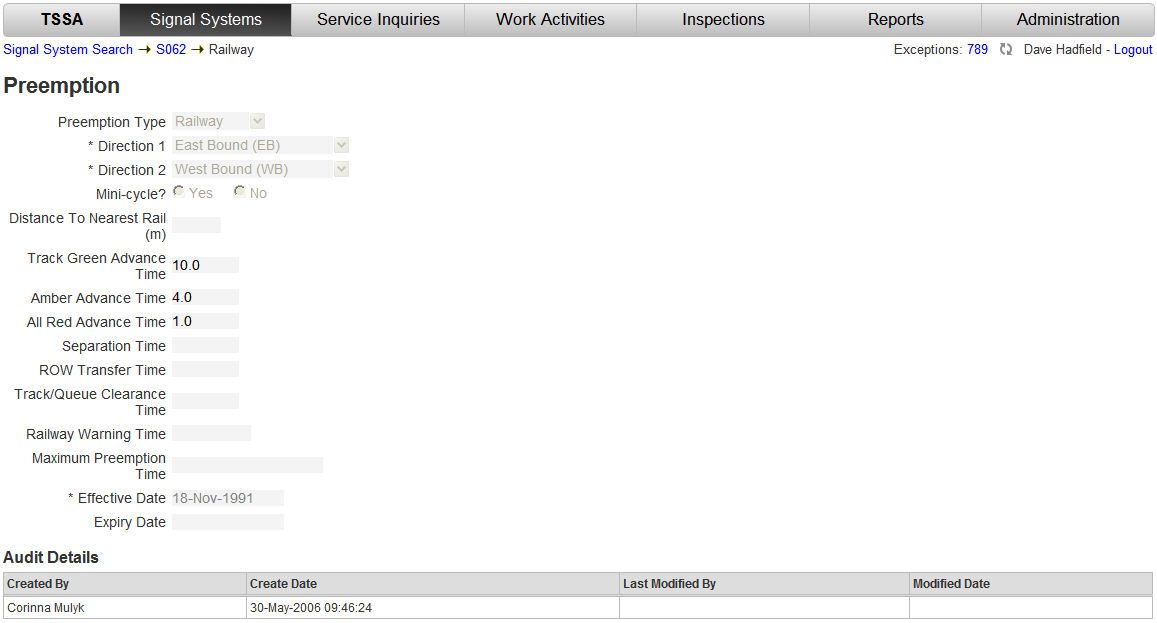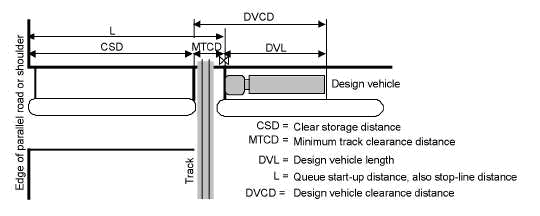|
Field
|
Description
|
|
Preemption Type
|
When creating a new Preemption record, this is the only field displayed. Once a choice is made the other fields appear.
Preemption Types are:
- Emergency Vehicle
- Railway
- Priority
|
|
Direction 1
|
The direction impacted by the preemption.
- North Bound (NB)
- South Bound (SB)
- West Bound (WB)
- East Bound (EB)
- Northeast Bound (NEB)
- Northwest Bound (NWB)
- Southeast Bound (SEB)
- Southwest Bound (SWB)
|
|
Direction 2
|
A second direction impacted by the preemption.
|
|
Mini-Cycle?
|
Indicates a mini cycle exists or not. A mini cycle is a traffic signal that can continue to cycle through certain traffic movements while the railway crossing is being preempted.
|
|
Distance to Nearest Rail (m)
|
The distance to Nearest Rail considers situations where the road crossing the tracks intersects with a road running parallel to the tracks. The signal system at the intersection requires the preemption.
If a road runs parallel to the tracks then the Distance to Nearest Rail starts 2m from the nearest rail, along the approach road to the parallel road's shoulder (or edge). This distance (clear storage distance) is compared with the design vehicle length (DVL).
|
|
Track Green Advance Time
|
The worst case vehicle phase (in seconds) that must display a green indication before the controller unit will terminate the phase through its yellow change and red clearance intervals and transition into preemption (i.e., track clearance green interval).
|
|
Amber Advance Time
|
The required yellow change interval time for the worst case vehicle phase given prevailing operating conditions. The normal yellow change interval should not be shortened or omitted during the transition into preemption control.
|
|
All Red Advance Time
|
The required red clearance interval for the worst case vehicle phase given prevailing operating conditions. The normal red clearance interval should not be shortened or omitted during the transition into preemption control.
|
|
Separation Time
|
A time 'buffer' between the departure of the last vehicle (design vehicle) from the railroad crossing (minimum track clearance distance) and the arrival of the train. Separation time is added for safety reasons and to avoid driver discomfort. Minimum recommended value is 4 seconds.
|
|
ROW Transfer Time
|
The Right of Way Transfer Time is the time required to end the worst case conflicting phases plus the time is takes for the controller software to begin to respond to the preempt call. In other words the amount of green, amber and red time that must display during the transition into preemption.
|
|
Track/Queue Clearance Time
|
The total amount of time required (after the signal has turned green for the approach crossing the railway tracks) to begin moving a queue of vehicles through the queue start up distance (distance from signal stop line to stop line on far side of crossing) and then move the design vehicle from a stopped position on the far side of the crossing completely through the minimum track clearance distance (completely clear of tracks).
|
|
Railway Warning Time
|
The amount of time between when the railway equipment sends notification of an oncoming train to the traffics signal controller and the arrival of the train at the crossing.
|
|
Maximum Preemption Time
|
It is the sum of Right-of-Way Transfer Time, Track/Queue Clearance Time and desired minimum Separation Time.
The total amount of time required after the preempt is initiated by the railroad warning equipment to:
-
complete right-of-way transfer to the track clearance green interval,
-
initiate the track clearance phase,
-
move the design vehicle out of the crossing's minimum track clearance distance,
-
and provide a separation time 'buffer; before the train arrives at the crossing.
|
|
Effective Date
|
The date the preemption was installed. (i.e. dd-mmm-yyyy 27-Jul-2011)
|
|
Expiry Date
|
The date the preemption was removed or inactivated.
|
|
Button
|
Description
|
|
Calendar

|
Used to select a date versus entering the date value manually (dd-mmm-yyyy - 15-Jul-2011). Available on all Date fields.
|
|
Save

|
The Save button (only available with Edit security) commits the changes made to the fields in the screen to the TSSA database.
|




